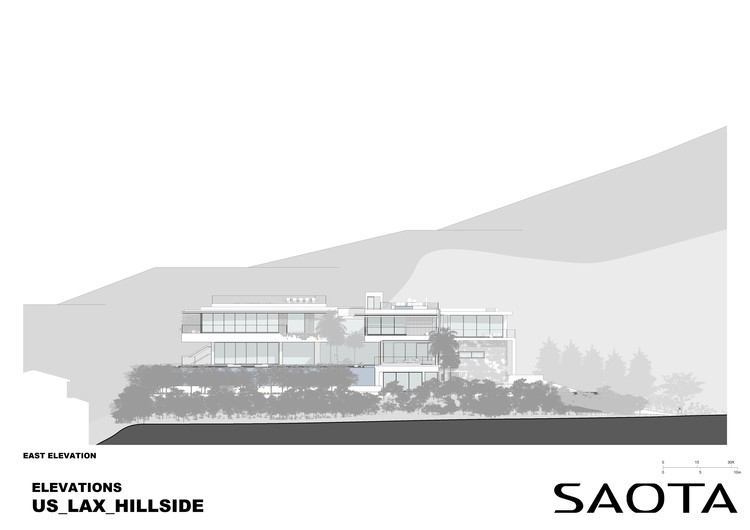
-
Architects: SAOTA
- Area: 1687 m²
- Year: 2019
-
Photographs:Adam Letch
-
Manufacturers: Antonio Lupi, Henge, Minotti, Porada
-
Architect of Record: Woods + Dangaran

Text description provided by the architects. SAOTA’s Hillside home in Los Angles is located immediately above Sunset Boulevard on a promontory just one over from Pierre Koenig’s landmark Stahl House. The site is a 20 000 square foot estate, featuring 300-degree views over the LA skyline and the city basin below, and the design was conceived of more as a self-contained oasis rather than a conventional house. The Stahl House served as a key point of departure. The forms and articulation of Hillside’s roof planes, which were pushed as far forward as possible so that they could create meaningful external covered living spaces, set its architecture in dialogue with the iconic silhouette nearby and connect it to the drama of its context.




The projecting eaves and soffits create a fifth façade proved fortuitous in creating a sense of identity because the wraparound perimeter views necessitated the carefully controlled placement of solid walls and extensive use of glass to maximize the panoramic potential of the site. Consequently, the architecture is defined through the floating, overlapping horizontal floor and roof plates curating specific view axes rather than mass walls or external structure. The steep approach from below resulted in a dramatic entrance through a top lit central atrium rising via a 12 car underground garage and an indoor waterfall cascading into a courtyard before surfacing into the centre of the living level in a dramatic moment of revelation as a dead-on view of downtown LA opens up.

The program is arranged around this focal view, loosely forming two wings, one oriented east-west, and the other north-south. The largely open-plan interior, in the absence of mass walls, has been articulated vertically and through volumetric changes to rationalize the layout. References to modernist construction techniques are picked up in the articulation of the steel columns and the sensuous and tactile use of timber and limestone on the floors and wall, which is carried extensively throughout the interior and exterior detailing. Some of the identifying features such as the cut-outs in the roof have been reprised in the detailing of the interior ceilings to add interest.



In keeping with SAOTA’s extensive experience in developing seamless indoor/outdoor open-plan living spaces appropriate to their base in Cape Town, South Africa, where the Mediterranean climate and topography are very similar to that in LA, they conceived of the program as a series of living rooms connected to extensive covered outdoor terraces. These outdoor spaces are in turn enclosed by a vast undulating infinity pool and lush landscaping along the perimeter, subtly screening neighboring properties (and ensuring their privacy) with climbing ficus trees. In keeping with the principles taken from the Stahl House and the ground-breaking Los Angeles Case Study Houses, which were built between 1945 and 1966, the generous allocation of outdoor space maximizes the potential of the livable climate, reconnecting contemporary LA architecture with a somewhat lost aspect of its modernist heritage.
















































